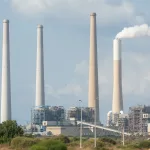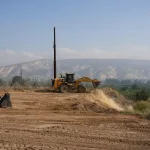- Business
- Technology
Browse Technology
- Politics
Browse Politics
Latest in Politics
Negev Cities to Receive $31.8M Boost for Housing, R&D, and Airport Plans
1 day agoIsrael, Bolivia Restore Diplomatic Relations
2 days agoCyber Weaknesses Put Israeli Elections, Democracy at Risk, State Comptroller Warns
3 days agoIsrael Begins Construction of Security Barrier Along Jordanian Border
4 days ago - Security
Browse Security
Latest in Security
‘Dual Roles Undermine Trust in Media’: Most Journalists Killed in Gaza Had Terror Ties, Study Finds
1 day agoIsrael Reports Sharp Decline in Illegal Border Crossings from Egypt
3 days agoCyber Weaknesses Put Israeli Elections, Democracy at Risk, State Comptroller Warns
3 days agoIsrael Begins Construction of Security Barrier Along Jordanian Border
4 days ago - Economy
Browse Economy
Latest in Economy
Negev Cities to Receive $31.8M Boost for Housing, R&D, and Airport Plans
1 day agoHaredi Enlistment Would Ease Army and Economic Strain, Bank of Israel Says
1 day agoIsrael, Costa Rica Sign Free Trade Deal, Eliminate Over 90% of Tariffs
4 days ago13th meeting of the Israel-Ukraine Joint Economic Commission held in Jerusalem
1 week ago - Crime
Latest in Crime
Israel’s Anti-Corruption Chief Investigated for Alleged Ties to Crime Network
2 days agoIsraeli Police Probe Fatal Shooting as Arab-Sector Murder Toll Climbs to 241
2 days agoIsraeli Authorities Charge Ashkelon Resident Over Months-Long Ties to Iranian Operatives
1 week agoIsrael Confirms Return of Sudthisak Rinthalak’s Remains
1 week ago - Society
Browse Society
Latest in Society
- Services
Travel & Transportation
Technology & Utilities
Religious & Cultural
Information & Directories
Government & Public Services
- Breaking News
Research reveals Arctic region was permafrost-free when global temperatures were 4.5˚ C higher than today
The stark findings indicate that if average global temperatures were to rise by this amount in the future, permafrost found in the Northern Hemisphere today would thaw.
Such a temperature increase would release up to 130 billion tonnes of carbon currently frozen in the ground over the coming decades.
The international team of researchers, which included experts from the Geological Surveys of Israel, Northumbria and Oxford universities in the UK, Bern University in Switzerland, and of the USGS, came to this conclusion after studying more than 60 mineral deposits obtained from caves in the Lena River delta region of north-eastern Siberia.
Their were recently published in Nature Communications.
Cave mineral deposits such as stalagmites and stalactites can only form when rain and snow meltwater seep through soil and rocks, slowly forming deposits in caves below the ground. These deposits cannot form when the ground above the caves is frozen, as it is today across large areas of Siberia and other regions bordering the Arctic Ocean.
The study relied on a high-precision technique which uses the radioactive decay of naturally occurring uranium in the deposits to form lead, known as uranium-lead dating.
By measuring the tiny amounts of uranium and lead found in deposits obtained from caves in the Taba-Ba’astakh cliffs in the far north of Siberia in a specialist laboratory at the University of Oxford, the authors of the study were able to determine that the minerals formed 8.7 million years ago during the late Miocene period.
The presence of water to form the cave deposits indicates that the ground temperature was above 0˚˚ C meaning that the permafrost currently found in the region was absent 8.7 million years ago.
Existing records from other regions demonstrate that, at that time in the past, average global temperatures were 4.5˚ C higher than those experienced today.
This indicates that warming of 4.5˚ C is sufficient to melt the vast majority of permafrost in the Northern Hemisphere, with permafrost-free conditions extending all the way to the northerly coast between Asia and the Arctic Ocean.
Today’s permafrost contains vast amounts of carbon, captured as dead plant material is frozen into the soil layer. Thawing of the permafrost would release this carbon back to the atmosphere and would further increase warming.
The study was funded by the Natural Environment Research Council and the Leverhulme Trust.
Link to the research





















